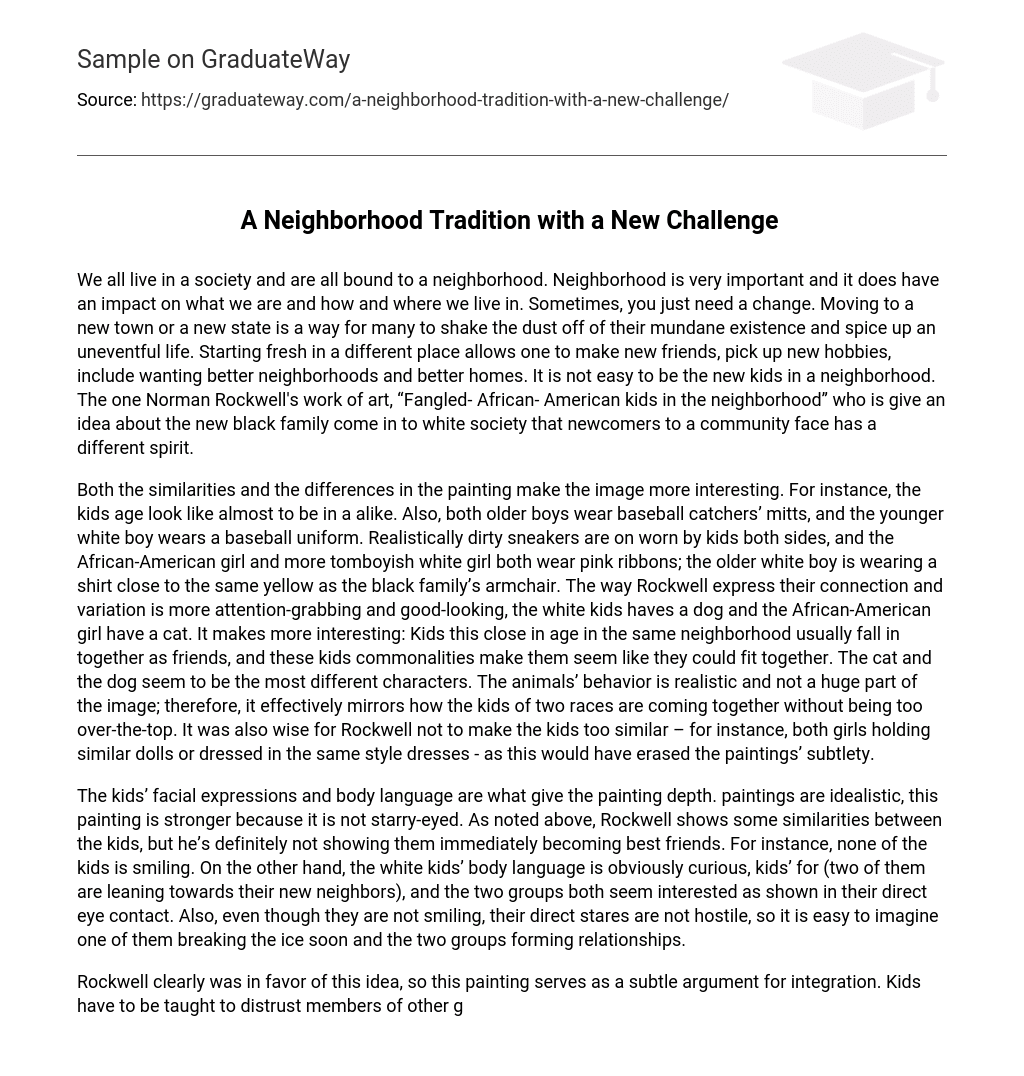We all live in a society and are all bound to a neighborhood. Neighborhood is very important and it does have an impact on what we are and how and where we live in. Sometimes, you just need a change. Moving to a new town or a new state is a way for many to shake the dust off of their mundane existence and spice up an uneventful life. Starting fresh in a different place allows one to make new friends, pick up new hobbies, include wanting better neighborhoods and better homes. It is not easy to be the new kids in a neighborhood. The one Norman Rockwell’s work of art, “Fangled- African- American kids in the neighborhood” who is give an idea about the new black family come in to white society that newcomers to a community face has a different spirit.
Both the similarities and the differences in the painting make the image more interesting. For instance, the kids age look like almost to be in a alike. Also, both older boys wear baseball catchers’ mitts, and the younger white boy wears a baseball uniform. Realistically dirty sneakers are on worn by kids both sides, and the African-American girl and more tomboyish white girl both wear pink ribbons; the older white boy is wearing a shirt close to the same yellow as the black family’s armchair. The way Rockwell express their connection and variation is more attention-grabbing and good-looking, the white kids haves a dog and the African-American girl have a cat. It makes more interesting: Kids this close in age in the same neighborhood usually fall in together as friends, and these kids commonalities make them seem like they could fit together. The cat and the dog seem to be the most different characters. The animals’ behavior is realistic and not a huge part of the image; therefore, it effectively mirrors how the kids of two races are coming together without being too over-the-top. It was also wise for Rockwell not to make the kids too similar – for instance, both girls holding similar dolls or dressed in the same style dresses – as this would have erased the paintings’ subtlety.
The kids’ facial expressions and body language are what give the painting depth. paintings are idealistic, this painting is stronger because it is not starry-eyed. As noted above, Rockwell shows some similarities between the kids, but he’s definitely not showing them immediately becoming best friends. For instance, none of the kids is smiling. On the other hand, the white kids’ body language is obviously curious, kids’ for (two of them are leaning towards their new neighbors), and the two groups both seem interested as shown in their direct eye contact. Also, even though they are not smiling, their direct stares are not hostile, so it is easy to imagine one of them breaking the ice soon and the two groups forming relationships.
Rockwell clearly was in favor of this idea, so this painting serves as a subtle argument for integration. Kids have to be taught to distrust members of other groups, so it makes sense for Rockwell to convey a sense of hope through children. The children’s lack of hostility make it possible to view this painting as having a hopeful tone. It’s not hard to imagine future summer nights when all these kids will get called home from playing freeze tag together when it is time for supper. In a small way, this painting helps normalize what still seemed a radical idea to many people at the time: kids of different races socializing.
For people who are used to Norman Rockwell’s more idealistic paintings, such as a perfect family smiling at Thanksgiving dinner or an attractive young couple sharing a perfect afternoon with a perfect dog and perfect basket of daisies, or playing baseball this painting. It could be surprisingly realistic. And a benefit of social issues that resist easy or quick fixes. This cautiously optimistic painting serves as a witness both to his talent and his social conscience.
Work Sited
- ‘New Black Kids neighborhood image’ 1967
- Norman Rockwell 1967 work, Best Norman Rockwell collection





